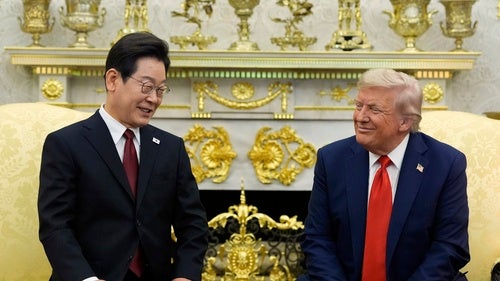Lee Touted South Korea as 'Pacemaker' in US-North Korea Relations—Why That Matters

In a meeting with Trump, South Korea’s president named his intention for the nation to serve as the beating heart of diplomatic relations in the region.
There were many ways the August 25 summit between US President Donald Trump and South Korean President Lee Jae Myung could have gone wrong. Just hours before, Trump cast a cloud over the scheduled meeting when he posted on Truth Social that South Korea might be undergoing a “Purge or Revolution,” sending South Korean officials scrambling and prompting concern that a Zelenskyy-style Oval Office blowup could be in the offing. Instead, the two leaders seemed to strike an easy rapport, and Lee Jae Myung framed his country as the “pacemaker” to Trump’s “peacemaker” in a remark that should help reshape how we think about South Korea’s foreign policy in the coming years.
Lee’s remark was more than just a clever play on words. South Korea officialdom has worried about the United States and North Korea meeting bilaterally and cutting Seoul out of the process—a concern referred to as “Korea Passing” in Korean media. By framing South Korea as a “pacemaker,” Lee stressed the importance of the nation in keeping the heart of diplomacy beating regularly, even amid stalled relations between Washington and Pyongyang. The first test of South Korea’s new role will be come during the Asia-Pacific Economic Cooperation (APEC) summit in South Korea in October. Trump seemed to suggest that he planned to attend the meeting and would be open to meeting North Korean leader Kim Jong Un, perhaps at the Korean demilitarized zone (DMZ), though Trump’s attendance at the summit has not been confirmed.
In addition to establishing South Korea as a vital partner in diplomatic negotiations, the idea of South Korea as a “pacemaker” communicates the larger role South Korea envisions for itself in the region. Trump’s irregular and unpredictable approach to foreign policy has led to frayed relations with allies and partners around the world. Lee’s turn of phrase positions South Korea as an ally that is ready and willing to help bring some kind of normalcy to international relations. Conveniently, Lee’s aim to establish closer ties to China—which speculation painted as a pain point with the United States—would also fall under this relationship framework.
On his way to Washington, Lee stopped in Tokyo to meet with Japanese Prime Minister Shigeru Ishiba to demonstrate that he was intent on working with Japan in the larger context of US priorities in Asia. In doing so, Lee was able to head off criticism of his administration’s relations with Japan. Diplomatic relations with Japan under progressive presidents—of which Lee is one—have turned toxic in the past, and Lee has thus far made efforts to ensure that this history will not be repeated under his leadership. In the past weeks, he singled out former President Moon Jae-in’s handling of Japan as an example that should not be followed.
Lee’s initial meeting with Trump did not and could not resolve all the challenges embedded in the US-Korea relationship. South Korea’s defense allocation will remain a point of focus for the United States. The country currently spends 2.3 percent of its GDP on defense, and large increases in that spending remain difficult due to economic uncertainty brought about, in part, by Trump’s tariffs. When members of the press were invited in, Trump bashed—mistakenly, of course—Biden’s handling of burden-sharing with South Korea. Trump’s claim was that South Korea had stopped paying the United States to support the deployment of US troops to the peninsula. In reality, Biden extended the Special Measures Agreement that governs South Korea’s contributions, which had been negotiated during Trump’s first term. Yet even with such an agreement in hand, Trump will likely continue to pressure South Korea to pay more. Finally, there are the economic agreements on issues like South Korea’s purchase of US agricultural goods and beef products that need to be worked out.
In all, the first meeting between Lee and Trump did not go off the rails and ultimately felt like a plan coming together for Lee. He addressed US priorities by making a stop in Japan before visiting Washington. He used effusive flattery to make a good impression. And he was able to deliver a memorable line that helps to reshape how we should think about South Korea’s foreign policy for the next four years. Not a bad start. Now, we wait for the deliverables from behind closed doors.

